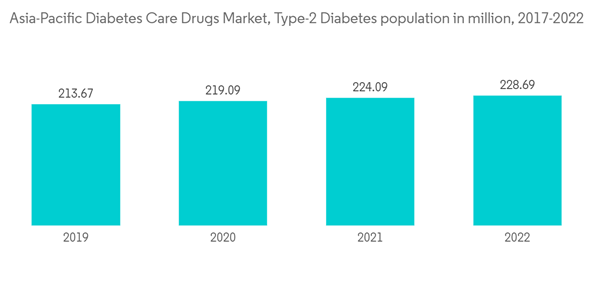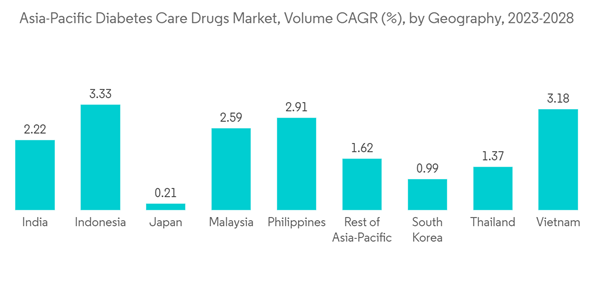The Asia-Pacific market for diabetes has witnessed a gradual increase in the demand for diabetes drugs during the COVID-19 crisis. According to a study by BeatO in 2021 on 800 people, patients with COVID -19 and pre-existing diabetes have experienced blood glucose level fluctuations, which has eventually led to a high demand for advanced drugs to treat diabetes. However, to lessen the devastating impact of COVID-19, Novo Nordisk has launched a new social responsibility strategy to defeat diabetes to provide access to affordable diabetes care to patients in every country.
Over the past few decades, Asian countries have witnessed a rapid increase in diabetes patients, especially those with type 2 diabetes. Developing countries have more than 70% of the global diabetes population. The Asia -Pacific is anticipated to experience considerable growth due to a more geriatric population and rising prevalence of diabetes mainly due to the enhanced stress level, sedentary lifestyles, smoking, and excessive consumption of alcohol that elevates the body's sugar levels have led to the growth of the market. Moreover, the production basis of certain antidiabetic drug companies in the region also boosted the market growth. However, the increasingly high cost of drugs is considered one of the major restraining factors for the market. According to the OECD iLibrary in Asia-Pacific, about 227 million people live with type 2 diabetes and about half of them are undiagnosed and unaware of developing long-term complications. Also, according to the International Diabetes Federation data, 90 million adults in the age group of 20-79 are living with diabetes in the South-East Asia (SEA) Region in 2021 which is projected to increase to 113 million by 2030 and 152 million by 2045.
Therefore, owing to the aforementioned factors the studied market is anticipated to witness growth over the analysis period.
Asia-Pacific Diabetes Care Drugs Market Trends
Oral Anti-Diabetes Drugs Segment occupies the highest market share in the Asia-Pacific Diabetes Drugs Market in the current year
The oral anti-diabetes drug segment occupied the highest market share in the Asia-Pacific diabetes drug market in the current year and is expected to register a CAGR of about 3.1% over the forecast period.Oral anti-diabetic drugs have been available internationally and are recommended for use when escalation of treatment for type-2 diabetes is required along with lifestyle management. Oral agents are typically the first medications used in the treatment of type-2 diabetes due to their wide range of efficacy, safety, and mechanisms of action. Antidiabetic drugs help diabetes patients keep their condition under control and lower the risk of diabetes complications. People with diabetes may need to take antidiabetic drugs for their whole lives to control their blood glucose levels and avoid hypoglycemia and hyperglycemia.
Oral anti-diabetic agents present the advantages of easier management and lower cost, so they became an attractive alternative to insulin with better acceptance, which enhances adherence to the treatment. The use of oral anti-diabetes drugs is rising since new-generation oral drugs, such as DPP-4 and SGLT-2, reduce the rate of CV risk in diabetes patients. SGLT-2 and GLP-1 are linked to lowering the mortality rate more effectively than DPP-4 inhibitors. Meglitinide and sulfonylureas are oral hypoglycemic drugs that directly arouse the discharge of insulin from pancreatic beta cells.
The Asia-Pacific region has witnessed an alarming increase in the prevalence of diabetes in recent years. In developing countries such as China and India, the rate of diabetes is at an all-time high. Patients with diabetes require many corrections throughout the day for maintaining normal blood glucose levels, such as oral anti-diabetic medication or the ingestion of additional carbohydrates, by monitoring their blood glucose levels. Leading manufacturers are focusing on technological innovations and the development of advanced products to gain a substantial share of the market.
Thus, owing to the above-mentioned factors, it is expected to drive segment growth over the forecast period.
China holds the highest market share in the Asia-Pacific Diabetes Drugs Market in the current year
In the Asia-Pacific region, China has been recognized as a potential developing market due to the growing diabetic population in this region. China is a mature market with some associated challenges, like slow economic growth, an aging population, and increased competition. In this region, there is a growing preference for oral anti-diabetics among type-2 diabetic patients, thereby leading to the growth of the market studied. China has the highest market share and contributes significantly to the global diabetes drug market. The country is witnessing a significant increase in the number of generic drug manufacturers. Furthermore, the leading global players in the market studied are facing intense competition from regional players.Patients can get medicines directly from the hospital pharmacy without a referral. Despite the implementation of national health insurance and its universal coverage, a large proportion of outpatient drugs are still required to be paid for. To reduce the burden on patients, China began implementing a National Essential Medicine System, which aims to guarantee the use of drugs by patients. As per the National Health Commission, China has taken steps to reduce diabetic patients' medical expenses by reimbursing outpatients for more than half of their medication costs. According to a national metabolic disease clinical research center, more hospitals in China will establish National Metabolic Management Centers (MMC) as part of their exploration of a new model of diabetes treatment, giving a boost to the market over the analysis period.
Asia-Pacific Diabetes Care Drugs Industry Overview
The Asia-Pacific diabetes care drug market is fragmented, with a few key manufacturers gaining a presence in major countries while the remaining market comprises other local or region-specific manufacturers. Mergers and acquisitions that happened between players in the recent past helped companies strengthen their market presence as well as drive innovation.Additional Benefits:
- The market estimate (ME) sheet in Excel format
- 3 months of analyst support
This product will be delivered within 2 business days.
Table of Contents
Companies Mentioned (Partial List)
A selection of companies mentioned in this report includes, but is not limited to:
- Astellas
- AstraZeneca
- Boehringer Ingelheim
- Bristol Myers Squibb
- Eli Lilly and Company
- Gan and Lee
- Janssen Pharmaceuticals
- Merck And Co.
- Novartis
- Novo Nordisk A/S
- Pfizer
- Sanofi Aventis
- Takeda
Methodology

LOADING...










